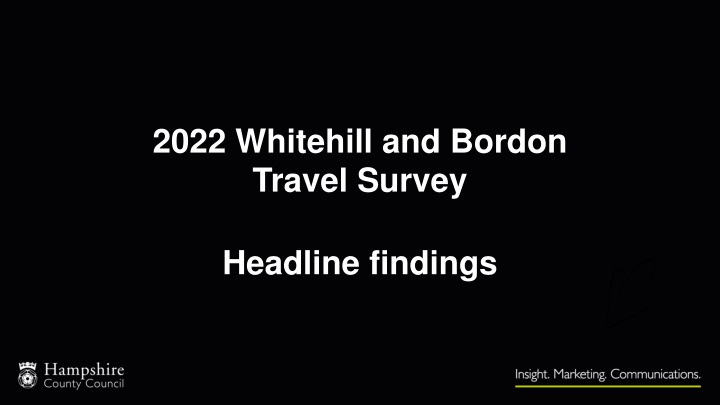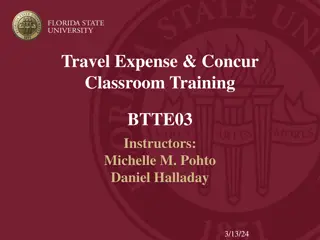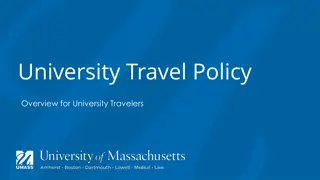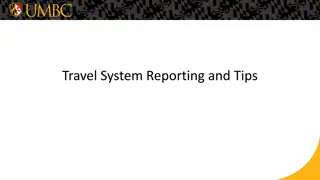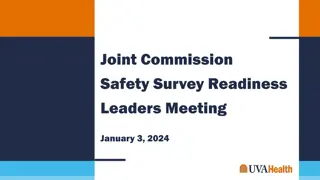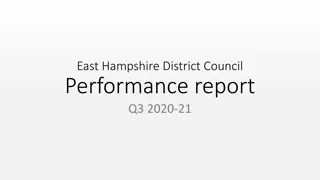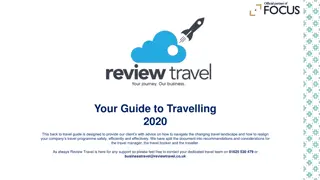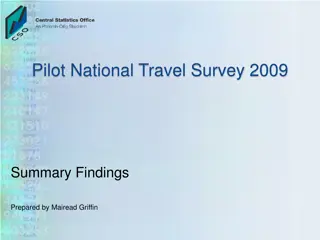2022 Whitehill and Bordon Travel Survey Headline Findings
The 2022 Whitehill and Bordon Travel Survey reveals key insights on transportation preferences and challenges in the area. Motor vehicles remain the primary mode of transport, while issues such as accessibility and cost impact the use of public transport and cycling. The survey highlights opportunities to enhance walking infrastructure and the need for improved public transport services, particularly rail. Satisfaction with the Whitehill and Bordon Green Loop is notable, but gaps in transport options persist, affecting various segments of the population.
Uploaded on Mar 12, 2025 | 1 Views
Download Presentation

Please find below an Image/Link to download the presentation.
The content on the website is provided AS IS for your information and personal use only. It may not be sold, licensed, or shared on other websites without obtaining consent from the author.If you encounter any issues during the download, it is possible that the publisher has removed the file from their server.
You are allowed to download the files provided on this website for personal or commercial use, subject to the condition that they are used lawfully. All files are the property of their respective owners.
The content on the website is provided AS IS for your information and personal use only. It may not be sold, licensed, or shared on other websites without obtaining consent from the author.
E N D
Presentation Transcript
2022 Whitehill and Bordon Travel Survey Headline findings
Background Between 17 October 2022 and 13 November 2022, Hampshire County Council ran a survey to understand the views of people who travel around the Whitehill and Bordon area. This survey was a follow-up from similar surveys run in 2018 and 2020*. The survey aimed to help inform travel plan measures that would benefit local residents, while also reducing carbon emissions and the environmental impact of transport in the Whitehill and Bordon area. 538 valid responses were received to the survey, including: 88 respondents with a health issue or a disability 61 respondents from ethnic minority backgrounds 253 respondents with carer responsibilities 437 users of train services and 227 users of public bus services 126 users of community transport services, such as Taxishare or Call & Go 161 cyclists Hampshire County Council would like to thank everyone who took the time to share their views, experiences, and ideas. *The 2018 survey received 400 responses, while the 2020 survey received 497 responses
Headline findings Motor vehicles were the most commonly used means of transport for all types of journeys, with fewer respondents travelling around Whitehill and Bordon by foot, bike, public transport and lift share in 2022 for a range of planned journeys compared with in 2020 About 6 in 10 respondents from ethnic minority backgrounds or with health or disability issues felt they had missed opportunities to go out due to a lack of suitable transport options, a similar proportion having experienced loneliness for the same reason Respondents were more likely in 2022 to feel that journeys would be more difficult if undertaken solely by public transport than they did in 2020 About half of respondents felt that accessing a train station was a barrier to increasing their use of train services, while service frequency was the main barrier to increasing use of bus services Respondents could be most effectively encouraged to walk more around Whitehill and Bordon by improving walking links within the area (such as with new bridges, paths and ramps), and addressing concerns about safety when using walking routes Feelings were split regarding satisfaction with cycling routes in the area. Connectivity was most often mentioned by those satisfied and safety concerns most often mentioned by those dissatisfied with these facilities Cost is the greatest barrier to electric car ownership, particularly amongst those with lower household incomes There is strong satisfaction with the Whitehill and Bordon Green Loop, with respondents frequently saying that they enjoyed using it Further comments frequently mentioned a perceived need for more public transport infrastructure, particularly regarding rail services
Types of journeys undertaken Car usage is high for all journeys undertaken in Whitehill and Bordon Proportion of respondents undertaking journeys at least once per month Modes of transport used most frequently More frequently undertaken by Motor vehicle (78%), foot (46%), and bike (5%) Top-up food shops (base: 510) 87% These activities were undertaken by over 80% of all respondent groups examined Motor vehicle (90%), foot (16%), bike (3%), and bus (3%) Main food shops (base: 525) 87% Respondents who work in locations away from home (77%) Motor vehicle (88%), foot (44%), and train (11%) Socialising (base: 513) 74% Ethnic minority respondents (84%), Taxishare or Call & Go users (84%), and those with carer responsibilities (76%) Motor vehicle (88%), foot (15%), and train (10%) Going to work (base: 502) 73% Respondents with carer responsibilities (71%) Motor vehicle (90%), foot (16%), and bike (8%) Visiting villages in the area (base: 521) 65% Ethnic minority respondents (59%), those with carer responsibilities (50%), and those who work away from home (50%) Motor vehicle (86%), foot (32%), and bike (9%) Visiting leisure facilities (base: 509) 46% Respondents with carer responsibilities (58%), ethnic minority respondents (44%), and Taxishare or Call & Go users (44%) Motor vehicle (71%), foot (35%), bike (5%), and bus (5%) Going to a place of education (base: 483) 32% Respondents with a health issue or disability (39%), from households earning up to 30,000 per year (25%), and aged over 65 (23%) Motor vehicle (84%), foot (25%), and bus (4%) Medical appointments (base: 513) 18% Respondents with a health issue or disability (24%), from households earning up to 30,000 per year (13%), aged over 65 (9%), with carer responsibilities (9%), or from ethnic minority backgrounds (9%) Motor vehicle (90%), bus (6%), and train (5%) Hospital (base: 511) 8%
Types of journeys undertaken Changes between 2020 and 2022 The following changes were seen between the surveys in 2020 and 2022, although it can not be determined how much of this change is due to actual shifts in attitudes and behaviours and how much is due to other factors such as differences in the samples in the survey. There were reductions in the proportion of respondents who regularly travelled around Whitehill and Bordon for planned journeys by: foot (from 67% to 34%), bike (from 18% to 4%), bus (from 17% to 6%), lift share (from 15% to 6%), and taxi (from 10% to 2%) In 2020 64% felt they would regularly travel around the area by car or other similar motor vehicle after the COVID pandemic; the proportion who did so in 2022 was 92% Similarly, in 2020 20% felt they would regularly travel around the area by foot after the COVID pandemic ; the proportion who did so in 2022 was 34%
Public and community transport Public transport usage could be increased with better connectivity to a train station and more frequent bus services Proportion of respondents who undertake journeys by different transport modes at least once per month Main reasons for using this mode of transport Main factors preventing the use of this mode of transport Main ways to encourage greater use of this mode of transport Difficulty reaching station (52%) Cost of the service (46%) Not asked Not asked Train (base: 529) 18% Cost of parking (39%) Lack of alternative options (40%) Not frequent enough (63%) Improved frequency (65%) Improved reliability / punctuality (40%) Bus stops closer to home / destination (37%) Real-time info at bus stops (37%) Environmentally friendly (27%) Uses car instead (62%) Public bus services (base: 529) 13% Cost (22%) Does not go where respondent wishes (60%) Easy to arrange (24%) Unaware of the service (54%) A better understanding of the service (59%) Community transport (Taxishare or Call & Go) (base: 538) Cost of the service (24%) Lack of information on the service (46%) 3% Information on journey times (25%) Reliability / punctuality (21%) Uses car instead (46%) Ability to book online (24%) Sociable experience (21%)
Public and community transport Changes between 2020 and 2022 The following changes were seen between the surveys in 2020 and 2022, although it can not be determined how much of this change is due to actual shifts in attitudes and behaviours and how much is due to other factors such as differences in the samples in the survey. In 2020 the fourth most common barrier to increasing the usage of train services was difficulty getting to a train station (24%). In 2022 this was the most common issue cited (52%), with the most commonly mentioned issue in 2020 (cost, 51%) falling to second most frequently mentioned (46%) In 2020, the main barriers to increasing the use of public bus services were personal preference (60%), poor reliability or punctuality (40%), a lack of service information (36%, and not having anywhere to go (36%), which may have been a result of the COVID pandemic. In 2022, the main barriers to increasing bus usage were the frequency of services (63%), use of car as an alternative (62%), and the routes not serving the respondent s desired destinations (60%) While respondents in 2022 were more likely to suggest that usage of buses could be increased by having bus stops closer to homes and destinations (37%, compared with 23%), they were less likely to feel that better facilities at bus stops would do this (13%, compared with 25%) In contrast, respondents in 2022 were more likely to suggest that usage of taxishare could be increased by giving people a better understanding of the service (52%, compared with 39%), but were less likely to feel that this could be achieved by allowing online bookings (18%, compared with 25%)
Public and community transport Social isolation of vulnerable people is increased by a lack of transport options About half of respondents (52%) felt that they sometimes or often missed out on going out due to a lack of suitable transport. This was higher amongst: Proportion of respondents who undertake journeys who would find them difficult if they could only use public transport to make them Hospital (base: 354) 92% Going to work (base: 388) 81% those from ethnic minority backgrounds (63%), and Socialising (base: 470) 74% those with a health issue or disability (62%) Main food shops (base: 480) 72% Visiting villages in the area (base: 458) 72% Medical appointments (base: 468) 59% About a third of respondents (32%) had felt lonely as they were unable to travel due to lack of transport options. This was higher amongst: Visiting leisure facilities (base: 387) 59% Going to a place of education (base: 166) 59% those with a health issue or disability (60%), and Top-up food shops (base: 477) 48% those from ethnic minority backgrounds (57%) * Please note the low base size for this group
Public and community transport Changes between 2020 and 2022 The following changes were seen between the surveys in 2020 and 2022, although it can not be determined how much of this change is due to actual shifts in attitudes and behaviours and how much is due to other factors such as differences in the samples in the survey. Fewer respondents said that they sometimes or often felt lonely as a result of being unable to travel due to lack of transport options (from 45% to 32%) However, respondents were more likely to often miss out on going out due to a lack of suitable transport options (from 14% to 21%) Compared with in 2020, respondents were more likely to feel that activities would be more difficult if only using public transport: Proportion of respondents who undertake journeys who felt that these would be difficult or very difficult if only possible via public transport 94% 85% 84% 76% 76% 74% 70% 69% 64% 63% 63% 59% 55% 51% Hospital Going to / from work Main food shops Socialising Going to school or another place of education Medical appointments Leisure facilities 2020 2022
Active travel Most respondents walk around the area, but this could be encouraged further with better linking or walking routes and addressing safety concerns 71% of respondents reported that they travelled around Whitehill and Bordon by foot at least once per month Would any of the following encourage you to travel around Whitehill and Bordon by foot more often? (Multi code, base: 564) 33% Improving links within the area by connecting existing routes with new roads, paths, bridges, ramps, etc This was higher amongst: 31% Safer walking routes 21% I already travel by these means as much as I can those from ethnic minority backgrounds (80%), and 20% Improvements to recreational routes 19% Nothing could encourage me to travel around Whitehill and Bordon by foot more often 18% those carer responsibilities (80%) 20mph speed limits 15% Benches 13% Traffic calming measures 10% Signs This was lower amongst: 9% Improved mobile phone coverage 8% Having someone to walk with those with a health issue or disability (52%), and 6% Something else 6% A local group that I could go out with 4% those aged 65 or over (49%) Help to plan a route
Active travel Satisfaction with cycling in the area was mixed, with safety being the most frequently mentioned concern amongst those dissatisfied About half (51%) of respondents reported that owned a bicycle, with 24% saying they used it Of those with a view, 23% were satisfied with the cycling infrastructure in and around Whitehill and Bordon, with 26% dissatisfied with this. The main reasons given for satisfaction with the cycling infrastructure included: the availability of cycle routes (24%), Ownership was higher amongst: the connections between networks and local facilities (24%), and those from ethnic minority backgrounds (61%), and the availability of cycle parking (20%) The main reasons given for dissatisfaction with the cycling infrastructure included: those with carer responsibilities (58%) Concerns about safety (38%), the availability of cycle routes (29%), and personal experiences of the behaviours of cyclists in the area (13%) Ownership was lower amongst: The most commonly suggested ways to encourage cycling in Whitehill and Bordon included: those with a health issue or disability (32%), and more traffic-free cycle routes (28%), improving links within the local area (20%), and those aged 65 or over (21%) improving links connecting the local area to other places (19%)
Active travel Mobility scooter and wheelchairs users would like to see safer routes and better recreational options when using these methods 3% of respondents indicated that they used a wheelchair, and the same proportion indicated that they used a mobility scooter 23 wheelchair or mobility scooter users suggested ways to encourage travel around Whitehill and Bordon by these means more often. These most commonly related to: safer routes for these modes of transport (6 respondents), improvements to recreational routes (5 respondents), the implementation of 20mph speed limits (4 respondents), and a need for more benches in Whitehill and Bordon (4 respondents)
Active travel Changes between 2020 and 2022 The following changes were seen between the surveys in 2020 and 2022, although it can not be determined how much of this change is due to actual shifts in attitudes and behaviours and how much is due to other factors such as differences in the samples in the survey. Respondents satisfaction with cycling facilities in Whitehill and Bordon fell from 32% in 2020 to 23% in 2022 In 2020, the most commonly mentioned way to increase cycling in Whitehill and Bordon was by creating longer distance cycle trails (34%), which was only mentioned by 17% of respondents in 2022 - the fourth most common response There was little change in the suggested ways to improve walking in the area. The three most common suggestions in both years were improving links within the area (27%, compared with 21% in 2020), safer walking routes (26%, compared with 30% in 2020), and improvements to recreational routes (17%, compared with 23% in 2020)
Use of motorised vehicles Respondents most frequently travelled in motorised vehicles alone or with family members in diesel or petrol cars, with cost preventing greater uptake of electric cars Of motorised vehicle users, 50% most commonly travelled alone, 47% with family, and 3% with someone who was not a family member Which motorised vehicles do you travel by? (Multi code, base: 513) 6% of respondents owned an electric car, but a further 32% were considering buying one in the next few years Diesel / petrol car 93% This level of future uptake correlates strongly with household income, with 15% of those on household incomes below 30,000 feeling they may buy one, compared with 48% of those with household incomes of 60,000 or more Electric car 6% Hybrid car 5% Cost was also most commonly cited as a barrier to purchasing an electric car (76%), with other common reasons including: Motorbike 3% the lack of charging facilities at home (45%), and Van / lorry 3% concerns about the range of electric vehicles (42%) Other vehicles included motorhomes and minibuses Other vehicles 1%
Use of motorised vehicles People lift share to save money, socialise, and protect the environment, but are limited in doing so by needing to be flexible and not knowing of other people making the same journeys 13% of respondents indicated that they lift shared at least once per month The most common barriers identified for lift sharing included: The most common reasons given for lift sharing included: the lack of a consistent fixed journey (43%), to save money (35%), This was higher amongst respondents with a health issue or a disability (23%), and for company on journeys (25%), nobody else making the same journey (43%), those from households with incomes of up to 30,000 (17%) environmental reasons (24%), and concerns about sharing with unknown people (30%), and However, respondents from ethnic minority backgrounds were less slightly likely to lift share (10%) a lack of public transport options for the journey (24%) a lack of the flexibility needed for lift sharing (27%)
Use of motorised vehicles Changes between 2020 and 2022 The following changes were seen between the surveys in 2020 and 2022, although it can not be determined how much of this change is due to actual shifts in attitudes and behaviours and how much is due to other factors such as differences in the samples in the survey. The cost of electric car ownership is seen as more of a barrier to purchase in 2022 (76%), compared with 2020 (63%). However home charging facilities are seen as less of an issue (falling from 73% in 2020 to 45% in 2022), and charging when out also seen as less of an issue (falling from 47% to 39% over the same period) There was less of a shift in the barriers to lift sharing, where the three most common reasons stayed the same between 2020 and 2022: Don't make a fixed journey every day (43% in 2022, 36% in 2020) Nobody makes the same journey (43% in 2022, 38% in 2020) Sharing a car with unknown people (30% in 2022, 29% in 2020)
The Whitehill and Bordon Green Loop There was high satisfaction with the Green Loop, which was enjoyed by respondents, although this could be improved by addressing issues with signage and concerns over safety 71% of respondents were aware of the Green Loop It is a nice little escape into nature without having to travel far from home I enjoy walking around it and it s great to get the kids out in the fresh air when they stay with me 50% of those who used it did so for exercise, with 40% using it to spend time outdoors Well signposted with wide footpaths 68% of respondents with a opinion on the Green Loop thought it was good, while 7% felt it was poor Walk is peaceful and connects Bordon together Reasons for liking it included the pleasure respondents got from using it, the quality and quantity of signage, and views on the layout and connectivity of the Green Loop I find the signage a little confusing and easy to get lost in some places trails being overgrown in places making it dangerous Not mobility scooter-friendly. I can t use some of the route which then leaves me lost and feeling unsafe Reasons for not liking it included issues with the signage, concerns about safety on the Green Loop, and the quality of information available about the Green Loop Never seen a map Respondents most commonly felt that usage could be increased with access to a map of the Green Loop (50%) or there being more information available about it (35%), and more signage showing how to access it (34%)
Further comments Further comments most commonly mentioned a need for more public transport in the area Further comments about travelling in and around Whitehill and Bordon (multi code, coded using automated text recognition, base: 224) My children go to school in Alton and find the reduced number of buses impacts their journey. Sometimes the bus is already full by the time it gets to their bus stop and doesn t stop for them, meaning they have to wait a long time for the next one. More buses at peak and school/college hours are required Public transport is more or less non existent. No buses to Petersfield from Bordon despite NHS saying that's where we have to go for x-rays etc as health hub will not have the facilities A need for more bus services or infrastructure A need for more rail infrastructure Car needed for travelling around the area Issues with connectivity of areas by public transport Issues with frequency of public transport A need for more public transport (type not specified) Lack of reasons to travel around within Whitehill and Bordon Issues with cost of public transport 41% 23% 21% 19% 14% 12% No bus service so have to drive and too old to cycle, especially when so many cars going well over the limit and nothing being done about it 9% 9% Bordon needs a train station. Commuting out of town requires a car. Buses are too slow Concerns with road safety More pedestrian infrastructure needed Concerns with speed of traffic Issues with reliability of public transport More cycle infrastructure needed Issues with connectivity of areas by current infrastructure 8% 7% 5% 5% 5% Bordon needs a train station and direct links to London and Portsmouth. Bordon is cut off from everywhere 4% Enjoy living in the area You cannot realistically live in Whitehill and Bordon without driving a car 4% 3% Pleased with transport infrastructure Issues with roadworks Due to the lack of facilities/shops in Whitehill it is difficult to do anything without travelling by car 3% Issues with signs A need for more parking Issues with road crossing points Issues with signs A need for more taxi services Issues with transport information 3% 3% 3% There are no buses after 8pm allowing taxis to charge extortionate prices I feel there is still more traffic through the town than the ring road. We need a safe crossing on the A325 between the commons 3% 2% 2% 2% I would love to walk into Bordon but the Liphook road is too dangerous to consider this Issues with social isolation impacted by transport A need for more housing Issues with accessibility of area for those with disabilities Need for transport to hospital or medical appointments More waste disposal needed Issues with narrowing of roads Area is too large to rely on walking to get about Not enough transport infrastructure (type not specified) 2% 2% 2% 1% I moved to Bordon in March 2020 and since then I've really seen an improvement in the walking access such as the green loop, to continue this and make more paths would be great The main high street seems to be having many calming measures put in but this adds to the traffic 1% 1% 0.4% 0.4% Too much focus on cycling Issues with access for goods or heavy vehicles Electric scooters should be legalised 0.4% 0.4%
Methodology The survey was open from 17 October 2022 until 13 November 2022. It was an open survey, so respondents were self-selecting. The survey could be completed online or in paper format. Respondents could share their views as an individual, in an official capacity on behalf of an organisation, business or group, or in their capacity as a democratically elected representative. Most questions were optional, with only questions included to identify organisations, businesses, groups, or democratically elected representative who responded mandatory. The survey was communicated through a range of channels, including: emails and direct messages to stakeholders; Postcards delivered to around 7,000 households in the area; a County Council press release; social media posts; and items posted on community message boards. Open-ended responses were analysed by theme, using an inductive approach. This means that the themes were developed from the responses themselves, not pre-determined based on expectations, to avoid any bias in the analysis of these responses. Automated text recognition was used to code these.
Who responded? Of the 538 responses, 526 were from provided by individuals, 2 by democratically elected representatives, and 1 on behalf of an organisation (9 did not indicate the capacity in which they were responding). This section provides further detail about those responding as an individual Ethnic categorisation (base: 526) Length of time lived in Whitehill and Bordon (base: 524) Age of respondents (base: 526) Under 16 Up to 1 year 7% 16 to 24 2% Ethnic minority groups 11% 25 to 34 19% Between 1 and 2 8% years 35 to 44 23% Between 2 and 5 Non-ethnic minority 20% 45 to 54 22% 74% years groups 55 to 64 17% Over 5 years 61% 65 to 74 11% N/A - I do not live in Whitehill and 75 to 84 5% 4% Not specified 15% Bordon 85 or over 1% Prefer not to say 1% Prefer not to say
Who responded? Gender of respondents (base: 518) Gender identity the same as at birth? (Base: 514) Sexual orientation (base: 502) Bisexual 4% Female 65% Yes 96% Gay or lesbian 3% Male 33% Heterosexual or straight 82% No 0.4% Prefer to self-describe 0.2% Prefer to self describe 0.2% Prefer not to say 4% Prefer not to say 3% Prefer not to say 11%
Who responded? Number of days in the previous week in which respondents did at least 30 minutes of moderate or vigorous exercise (base: 514) Respondents whose day-to-day activities are limited because of a health problem or disability which has lasted, or is expected to last, at least 12 months (base: 564) 0 13% 1 8% Yes, a little 10% 2 14% 3 18% Yes, a lot 5% 4 10% 5 10% 6 4% No 82% 7 14% Don't know 5% Prefer not to say 2% Prefer not to say 4%
Who responded? Household income (base: 484) Carer responsibilities (multi code, base: 510) Up to 10,000 10,001 to 20,000 20,001 to 30,000 30,001 to 40,000 40,001 to 50,000 50,001 to 60,000 60,001 to 70,000 70,001 to 80,000 80,001 to 90,000 90,001 to 100,000 100,001 or over Don't know Prefer not to say 4% Primary carer for child(ren) aged under 18 30% 10% without disabilities 10% 9% Primary carer for disabled child(ren) aged 3% under 18 11% Primary carer for disabled adult aged over 4% 18 8% 8% Primary carer for an older person 4% 5% Secondary carer for someone (where another person carries out the primary 3% 2% 6% caring role) None of these 55% 6% 2% Prefer not to say 4% 22%
Who responded? Employment status (multi code,base: 519) Working patterns of respondents in employment (base: 381) Working as an employee 65% Only from home 11% Self-employed 10% Unemployed 4% Only from a location away from home 49% On a government sponsored training scheme 0% Away from work ill, or on maternity leave 2% A mixture of working from home and A student 2% 38% away from home Retired 17% None of these 3% Prefer not to say 2% Prefer not to say 2%
Who responded? Responses by postcode 10 1 response responses
